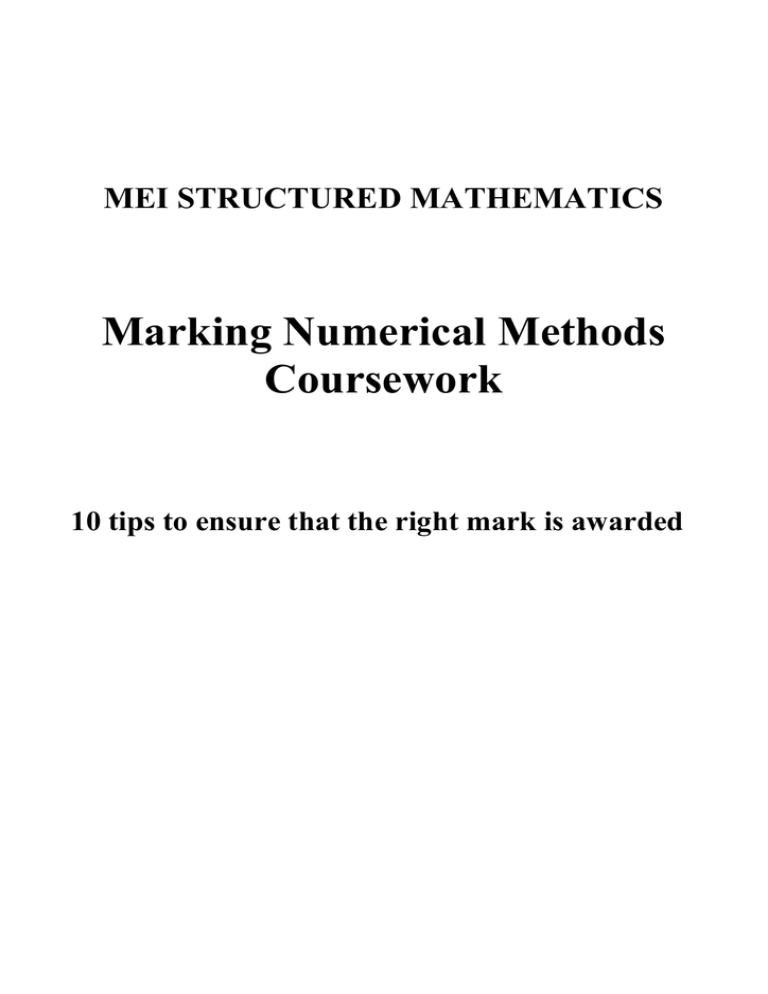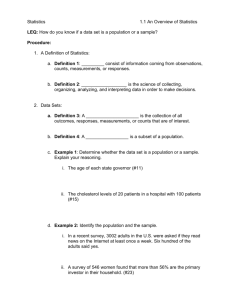Marking Numerical Methods Coursework MEI STRUCTURED MATHEMATICS
advertisement

MEI STRUCTURED MATHEMATICS Marking Numerical Methods Coursework 10 tips to ensure that the right mark is awarded Numerical Methods Coursework. What is required? “Candidates are expected to investigate a problem which is suitable for numerical solution, using one of the methods in the specification.” Rationale The module aims to develop skills in the areas of problems identification, use of numerical methods and control of error in practice. The coursework assignment should enable students to demonstrate a facility with technology and an awareness of the difficulties that can arise when computers are used to do mathematics. Description Students are expected to investigate a problem which is suitable for numerical solution, using one of the methods in the specification. Problems which have an analytical solution are acceptable only if the analytical solution is too time consuming, or too advanced to be feasible. Students should use a computer to develop a solution which is both effective and accurate. In particular, they must show how the desired accuracy has been achieved by means of sufficient iterations of the numeric process to ensure that accuracy has been achieved and by means of a theoretical analysis of errors. The coursework counts for 20% of the assessment and should take of the order of 6 - 8 hours. The report by which the task is assessed should be well written and easily readable to anyone who has not seen the task being completed. The report should be word-processed and contain the following: (i) Any graphs, using a software package (e.g Autograph) (ii) Easily readable script with all formulae written at least in Equation Editor if not Mathtype or equivalent (iii) Spreadsheet work with some formulae given. MEI Conference 2013 Marking Numerical Methods Coursework Page 2 1 Problem Specification The problem needs to be able to fulfil the criteria. If it is the solution of an equation then there must be the opportunity for error analysis. If it is numerical integration then it needs to be of a function that cannot be integrated. A “substantial” task, for numerical integration, should enable the student to compute at least M64. For solution of equations the task is not made substantial simply by finding more roots. The task should be given in precise mathematical terms. E.g. “I am going to find the area under the curve y = xx between 0 and 1” needs to be written at some 1 stage “I am going to find, by numerical integration, A x x dx . 0 2 Why is this task appropriate? Students need to explain why the task they have chosen is appropriate. It may seem trivial but that simply means it is an easy mark to earn, but also to lose! It is not necessary to demonstrate that the integral cannot be done by analytical means known to the candidate. 3 Strategy It is necessary for the candidate to explain why he or she has chosen the particular strategy - e.g. why did you choose Simpson’s Rule to do a numerical integration? Note that doing Midpoint, Trapezium and Simpson is not using an “appropriate procedure” but covering all options!! So the first mark would be gained but not the second. There may be a purpose in using all three methods, in which case that purpose needs to be stated. Statements such as “M gives an over-estimate and T gives an under-estimate” need to be justified. 4 Formula application This needs to be substantial. An application of Simpson, for instance, that goes as far as S16 would gain only 1 mark. Taking the work through to, say, S64, or to a stage where successive values are the same to 6 significant figures would gain the second mark. Evidence that it is all correct would get the third mark. MEI Conference 2013 Marking Numerical Methods Coursework Page 3 5 Use of technology The use of a spreadsheet is not specifically mentioned but should be taken to be obligatory!! The formulae used to obtain the spreadsheet values should be explained. All formulae for every line that covers a number of pages should be avoided! 6 Error analysis Demonstration of the order of the method is required here. Note that the actual value needs to be taken from within the work you are doing. To compare a numerical integration with a known value (obtained analytically perhaps) or by some other means (e.g. using “Derive” on a calculator) is obviously not acceptable. The “norm” for numerical integration is: Find differences Find the ratio of differences Make a deduction about the value to which the ratios are converging Use this value to extrapolate to infinity 7 Improvement Has there been an improvement in the solution as a result of the error analysis? 8 Solution Students often forget to say exactly what the answer is!! What are they looking for, so what have they found! 9 Accuracy The criterion says “e.g. 6 significant figures”. This is not a requirement. Students need to express their answer as accurately as possible within the work of the task. This in itself requires an understanding of the error analysis process. 10 Validity and limitations Some discussion needs to take place as to the validity of the method and hence the possible limitations of solution. This does not include the number of decimal places to which an excel spreadsheet works. MEI Conference 2013 Marking Numerical Methods Coursework Page 4




